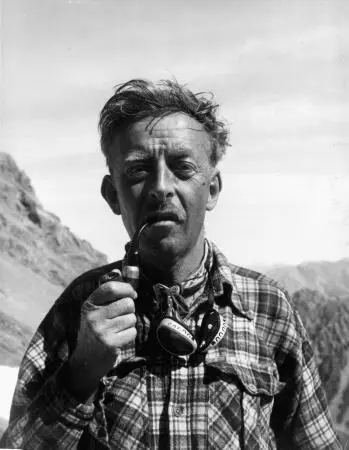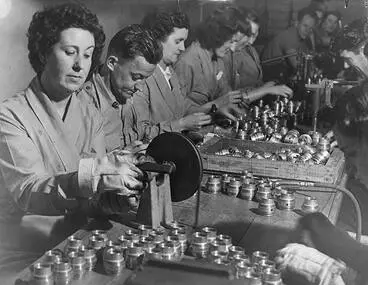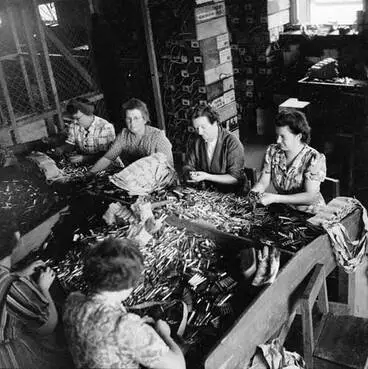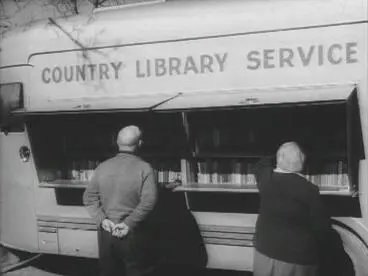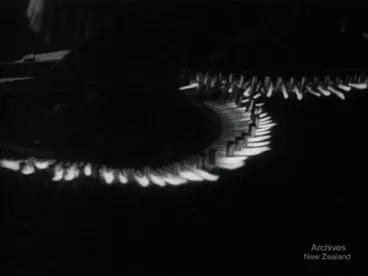WWII munitions factory in Hamilton East
A DigitalNZ Story by Zokoroa
During World War II there was a munitions factory in Hamilton East which had been relocated from Auckland for security reasons. The buildings were later used by the Ministry of Works and the regional branch of the National Library of New Zealand.
WWII, World War 2, World War Two, Hamilton, Munitions, Ammunition, Factory, Library, Country Library Service, School Library Service, National Library of New Zealand, National Library
During World War II an ammunition manufacturing plant in Dey Street, Hamilton East produced bullets for the war effort.
Group at work in a munitions factory during World War 2
Alexander Turnbull Library
Threat from Japan
The War Cabinet decided in January 1942 to relocate the Colonial Ammunition Company which had been operating in Mount Eden since 1885. The Minister of Supply and Munitions (Dan Sullivan) announced that with Japan entering the Pacific War, the factory would shift to a safer location away from the threat of a coastal attack. Various locations were considered and it was decided to set up the munitions factory in Hamilton. (See Evening Post, 18 Dec 1943.)
Colonial Ammunition Company (CAC), Auckland
Premises in Mount Eden were established in 1885; then shifted to Hamilton in 1942.
Alexander Turnbull Library
The steel frame shot tower, which was added to the Mt Eden factory in 1916, was used for the creation of lead pellets.
Colonial Ammunition Company premises, Mt Eden, Auckland
Alexander Turnbull Library
The copper AC badge has two crossed .303 cartridges and was made by Young and Co of Auckland.
badge
Auckland War Memorial Museum Tāmaki Paenga Hira
Factory built in Hamilton East, 1942
Suitable land was found in the Hamilton Domain Reserve's East Belt near the southern end of Dey Street. The decision was made to erect separate self-contained buildings dispersed over a large area rather than having a single large structure. The rationale being that production would only be partly affected "in the event of one unit being put out of action". (Evening Post, 18 Dec 1943). To reduce sighting from the air, the buildings were designed to have flat roofs and camouflaging.
Norton and Galloway plants
Twenty-four buildings were grouped along Dey Street on the northern and southern side of the intersection with Cambridge Road which links with Naylor Street. Hamilton builders erected the buildings and NZ manufacturers duplicated existing machinery, tools and dies from drawings made by New Zealand Railways draughtsmen.
Factory built both sides of Cambridge Rd intersection with Dey St (Galloway block to right of oval cycle track) (1967)
Hamilton East, including Galloway Park
Alexander Turnbull Library
Norton plant was located at the southern end of Cambridge Road and was thought to be named after the local farmer. In recent times, one of the buildings housed the hall of the No. 7 (City of Hamilton) Squadron Air Training Corps.
Galloway plant was located on the northern side of Cambridge Road between what is now the Hillcrest Stadium's oval cycle track and Kirikiriroa Marae. The plant may have been named after the nearby Galloway Park which is sited on Galloway Road. Galloway Road was named in 1895 after Major-General Thomas James Galloway who commanded the Auckland Milita and Volunteers, from Aug 1863 to Feb 1865.
Naylor Autos on top left left corner of Dey St & Galloway buildings top right
Just visible in the top right are some of the former Galloway ammunition factory buildings on Dey St in 1980.
Hamilton City Libraries
Photographic history captured by John Pascoe
John Dobrée Pascoe (1908-1972) was appointed official photographer for the Department of Internal Affairs to record aspects of wartime life in New Zealand. He travelled throughout the country between 1942 and 1945 on various assignments. The photographs Pascoe captured included the munitions workers in Hamilton during 1944 - at work and during their lunch breaks.
Photographer John Pascoe was appointed by the Department of Internal Affairs to record wartime life.
John Dobrée Pascoe, 1960
Manatū Taonga, the Ministry for Culture and Heritage
Munitions factory workers, Second World War
Manatū Taonga, the Ministry for Culture and Heritage
Lunch break for a group of women workers from a World War 2 ammunition factory in Hamilton
Alexander Turnbull Library
Factory Operational from 24 June 1942
Staff, machinery and materials were transferred from the Auckland premises during June 1942. Newspapers reported that "the first lots of ammunition were turned out of the new factory" on 24 June 1942. This was considered remarkable with the decision to relocate only announced five months earlier. (See Evening Post, 18 Dec 1943.) As many as 1200 people were employed in the plants at one time. Staff worked one of two eight hour shifts, six days a week. The rated capacity of the Hamilton factory was double that of the Auckland factory, which was exceeded within the first 12 months. Whereas the Auckland factory had produced 17 million rounds of ammunition in 1940, the Hamilton factory had produced 75 million rounds in its first year of operation.
Staff worked one of two eight hour shifts, six days a week & produced 75 million ammunition rounds in first year.
Women workers, Second World War
Manatū Taonga, the Ministry for Culture and Heritage
Some Workers were 'man-powered'
In January 1942, the Government passed the Industrial Man-power Regulations whereby workers could be directed where they were needed. Men and women were required to register at the local Man-power Office, which was a branch of the National Service Department. This action became known as "man-powered". In March 1942 all women aged from 22 to 25 years living in Hamilton and Cambridge were required to register for the munitions factory. (See NZ History.) Men who worked at the factory included businessman Sir William (Bill) Gallagher who was man-powered in 1942. (See Te Ara - Dictionary of NZ biography.)
Measures of man-power control in New Zealand
Auckland War Memorial Museum Tāmaki Paenga Hira
Dorrie Connelly (née Caitcheon) of Hamilton was also “man-powered” to work in the Hamilton factory. After a while working there she was promoted to the examining room: “I hated every minute of it and after several weeks I asked to go back into the main building...there are a different crowd of people [in the main building] and it wasn’t such intense work...I used to get headaches from examining the bullets...you had to examine for any little crack or flaw in them and I found it very tiring sitting under the fluorescent lights.” (Source: Hamilton City Libraries: "From the Great Depression to the ammunition factory: an interview with Dorrie Caitcheon",1995.)
Caption reads: "Examining the finished bullet is a preliminary to more searching tests later." (1944)
Woman working in a munitions factory in Hamilton during World War 2
Alexander Turnbull Library
Film includes the manufacture of ammunition in factories
Money for War (1942)
Archives New Zealand Te Rua Mahara o te Kāwanatanga
Working practices!
Dolly Dyer had volunteered at the Garden Place recruiting hut in February of 1942. After initially starting at the Auckland factory, she worked at the Hamilton plant: ‘‘We used to pack bandoliers. These had five pockets in them and five cartridges were placed in the pockets, then folded neatly and placed in a box that would take 15 of them. If they were not folded properly you could not fit them in. One woman used a mallet to hammer them down. I can tell you we were all scared. However she was told not to use it again.’’ (See Waikato Times, 12 Jan 2008.)
Filling clips and bandoleers with .303 cartridges
Women workers, Colonial Ammunition Company, Hamilton, during World War 2
Alexander Turnbull Library
Quality of ammunition produced steadily improved till it reached "All Services" standards - highest grade. (Dec 1943)
Woman working in a munitions factory in Hamilton during World War 2
Alexander Turnbull Library
Minister of Supply and Munitions (Mr. Sullivan) pays tribute to those involved with the Hamilton factory (Dec 1943)
FINE ACHIEVEMENT (Evening Post, 18 December 1943)
National Library of New Zealand
Moving trays of unnecked .303 cartridges
Female munitions worker at a factory in Hamilton, during World War II
Alexander Turnbull Library
Staff canteen
Left: Workers receiving hot dinners in servery at recreation centre; Right: Assembling 0.303in. rifle cartridges
Women workers at the Colonial Ammunition Company's works near Hamilton
Auckland Libraries
Caption reads: "Another angle of workers in the Recreation Centre restaurant. The meals are substantial" (13 Jan 1944).
Workers from a World War 2 munitions factory during their meal break, Hamilton
Alexander Turnbull Library
A small bakelite ashtray with moulded CAC badge and word "VICTORY".
ashtray
Auckland War Memorial Museum Tāmaki Paenga Hira
Magazine storage at Flynn Park
The manufactured bullets were stored in the magazine - a rectangular brick building with air vents with steel covers along two walls and a slate roof. The building, which is located in Flynn Park (formerly Marist Park), is currently leased from the Hamilton City Council as clubrooms by the Hamilton Light Horse Club. (See article and photo "Memory boxes" by Ann McEwan in Waikato Times, 3 March 2014.)
Shows manufacturing stages of .303 cartridges brass cartridge parts.
cartridge draw set
Auckland War Memorial Museum Tāmaki Paenga Hira
Staff Accommodation
Guards Huts were provided on the corner of Dey Street and Cambridge Road/Naylor Street. The employees and plant operational staff were housed in the sixteen Artillery Flats built on Peachgrove Road which had single unit and double units. Buses were provided to transport them to and from work.
Artillery Flats on Peachgrove Rd
Just visible at the bottom right of Peachgrove Int. School are the Artillery Flats.
Alexander Turnbull Library
Artillery flat on corner on Peachgrove Road near corner of Ruakura Road
Building at C.A.C. Hamilton operation.
Auckland War Memorial Museum Tāmaki Paenga Hira
Staff socialising
Marjory Carey writes in the Historical Review, 'Working in the ammunition factory in Hamilton" (Vol 43, 2, Nov 1995, pp. 103-104), "There was a big Recreation Hall further down the road at the other flats. We could go there for a meal if we didn’t want to cook our own. The Airforce at Rukuhia used to invite us to dances and so did the Army, We could go to the Sunday pictures, put on by the Forces provided we showed our Passes. There was plenty of sport...”
After the war, the CAC Recreation Hall was adapted into a Hostel and the adjacent area became the Borough Camping Ground to help ease the numbers of homeless people sleeping rough. (Source: New Zealand Society of Genealogists Inc. Hamilton Branch Newsletter, Feb 2016, p.4.)
Recreation and welfare centre for the use of workers and their families, sited on 13 acres
Welfare scheme for women workers at the Colonial Ammunition Company's works near Hamilton
Auckland Libraries
Post-war - office buildings
After Japan surrendered, production at the munitions factory slowed and eventually ceased. The machinery and equipment were then returned to Auckland.
Victory parade, Queen Street, Auckland Central, 1945
Auckland Libraries
The Norton buildings were converted to offices for the Ministry of Works district office (formerly the Department of Public Works). Over the decades, the Norton and Galloway buildings have also housed other organisations and government departments. The Country Library Service and School Library Service (Hamilton) branch of the National Library of New Zealand had its beginnings on the Norton site in 1953 (see Flickr Photo 1). The collections and staff then shifted to the Galloway site during September 1961 (see Flickr: National Library exterior Photo A and interior Photo B and Photo C).
Norton & then Galloway site housed Country Library Service & School Library Service branch of National Library.
Country Library Service, 1959
Manatū Taonga, the Ministry for Culture and Heritage
The Country Library Service mobile library vans also operated from the Dey Street premises.
Country Library Service.
Auckland War Memorial Museum Tāmaki Paenga Hira
DNZ story about the Country Library Service, including operations at Hamilton.
Country Library Service - Mobile Books!
DigitalNZ
The buildings at Galloway have since been demolished by the Hamilton City Council and the land used for a recreation reserve. Adjacent to Dey Street is the new arterial route - Wairere Drive - which is part of the Hamilton Ring Road that runs through Flynn Park to Cobham Drive. Various momentos from the Hamilton munitions factory are held by the Waikato Museum (see Waikato Times, 12 January 2008).
Sources:
- Carey, M. (1995). Working in the ammunition factory at Hamilton. Historical Review, 43, 2, 103-104.
- Flickr: Hamilton Country Library Service staff reunion, 2007 includes historical photos of the buildings
- Harris, L.H. (1981). A little further, a little faster: a nostalgic look at the Colonial Ammunition Company, its history and cartridges. Wellington: New Zealand Cartridge Collectors’ Club
- Ihaka, J. (1990). An old factory gets the bullet. Waikato Times, 12 (19 May)
- McEwan Ann (2014). Memory boxes, Waikato Times (3 March)
- Pass the ammunition (2008), Waikato Times (12 January)
Videos / Audio:
Munitions manufacturing, 1942
Manatū Taonga, the Ministry for Culture and Heritage
New Zealand Munitions
NZ On Screen
From the Great Depression to the ammunition factory: an interview with Dorrie Caitcheon.
Hamilton City Libraries
MONEY FOR WAR
Ngā Taonga Sound & Vision


